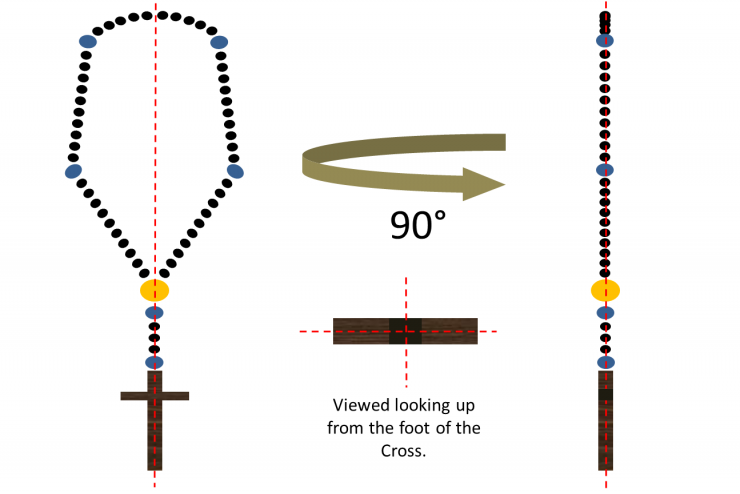
I have been praying the Rosary ever since a lady named “Cookie” sent me a hand-made set of beads in the mail as a gift. I remember looking at the necklace contraption wondering what exactly one is supposed to do with it.
What am I supposed to pray for?
What happens if I don’t do it correctly?
Why do I have to pray these prayers in this order?
I remember the day I asked my husband those questions in our kitchen, and his answer was characteristically concise. “Just pray, Honey.”
So, mostly out of a desire to appreciate the gift Cookie sent me, I picked up the plastic beads and prayer card and headed out for a walk, feeling kind of goofy meandering down the street, feigning prayers. By that point in my journey of faith, I had learned at least one simple truth: Even the smallest acts of faith require a little faith.
I just did it. I prayed my first Rosary.
Over the years, I developed a relationship with Mary through many prayers offered on those beads. In the spirit of passing on the gift that was given to me, I began to make Rosaries and mail them to people too. I learned to make knotted Rosaries because they are the most durable and safest for children, and I have since mailed thousands of Rosaries to people all around the world.
I spent a great deal of time studying the structure of the Rosary as I wrapped knot after knot around my finger and pulled it tight (three loops for the Hail Marys, four loops for the Our Fathers, a double-stranded double loop for the Center, and a three-by-two set of four-loop knots for the Cross). I could not help but analyze the order and symmetry. If my analytical mind had been perplexed by the purpose of praying the Rosary, it was even more curious about why every bead is placed just so.
There is an obvious order to the Rosary. There are five decades of ten Hail Marys each. Each decade is separated by one Our Father, and from the loop descends three more Hail Marys, faith, hope, and love, flanked by two more Our Fathers and a Crucifix on the end. There is even an order in how we pray the Mysteries. Order. Order. Order. But, I thought, what is the greater order? Am I missing something?
I tried in vain to figure it out. In total, there are fifty-three Hail Marys and six Our Fathers, which reveals nothing remarkable in terms of uniformity. There are no multiples of sevens or mathematical proportions in the numbers fifty-three and six. You could say that one Crucifix + two Our Fathers + three Hail Marys in the tail represent the first three prime numbers whose sum and product equal the same thing (1, 2, 3), except the number one is not really a prime number. You could say that, sure, the number one is the special number of all numbers, unity itself, but a Catholic does not need a set of beads to tell her that the Crucifix is special or Christ is unity, and the whole “what-does-the-structure-mean” question starts to sound like a fanciful stretch.
But still, I kept thinking, there must some kind of mystical symmetry in all this order. The most beautiful objects we observe in nature and build with our hands display order and symmetry. Cathedrals are exercises in complex geometry that require magnificent skill, labor, and expense because that is how we worship God. Butterflies are beautiful because they are symmetrical. Snowflakes are masterpieces because of their crystalline angles. The symmetry of the human body is proclaimed in artwork even to trigonometric detail. Science itself is founded upon the assumption of regularity and proportion. Even for gases, if the volume decreases, the pressure increases and vice versa, not by some random amount, but by an exact, calculable proportion for a given mass of gas at constant temperature.
The beauty in life—I started to realize over time—seems to derive from the order and symmetry that are broken though. Think about it. Cathedrals may be perfectly majestic when viewed from a distance, but up close we see that all lines are not perfectly straight, floors still need mopping, and roofs mending. Butterflies are not exactly mirrored images of wings, and they are most beautiful when they flutter about unpredictably. No snowflake is perfectly crystalline either, for it is the varied arrangement of matter that records the dust and gusts of each snowflake’s unique trajectory through time and space. No human body is without blemish, and no scientific model exists in absolute abstraction from a complicated reality. The kinetic theory of gases makes assumptions for the sake of calculation that “ideal” gas particles are tiny, hard spheres that collide in perfectly elastic collisions and experience zero intramolecular attractions. “Real” gases differ from “ideal” gases in those assumptions, lest no substance ever actually be able to freeze or melt.
And one day it hit me, because I have a knack for missing the obvious from a lifetime of obsessing about details.
The Rosary, these strings of beads made by human hands, so marvelously reminds us of that broken symmetry paradox of Creation. We may desire perfection, but in reality, the temples of our souls need cleansing and mending, our minds and hearts flutter about in often whimsical ways and, in doing so, tell the unique trajectory of our individual lives. Our relationships, if they are to last, demand that we learn to love the real person rather than the ideal one. For all the perfections we seem to reach for, the fullness of reality always exists beyond. We are not robots. We are human.
Even when we commit to praying the Rosary daily, we never achieve a flawless prayer life. Sometimes we forget to pray. Sometimes we half pray in anger. Sometimes we cry too hard to pray a word. Sometimes we pray in a hurry because we want to return to the book we were reading, and other times we pray so slow we fall asleep. Some Mondays the Joyful Mysteries are sputtered in despair. Some Wednesdays our spirits fall flat even as we announce the Ascension. And some Fridays we are distracted by our hardships while we pray the decade of Christ carrying the Cross. And this is exactly the reason we keep praying and trying. It is not so much that we need to be perfect, but that we strive to do better knowing and accepting that we remain wonderfully human.
And there is symmetry in the Rosary, but it is broken.
Among all the Hail Marys and scattered Our Fathers, in that circle attached to that tail, there actually are, precisely, two planes of perfect symmetry, and only two. If you lay your Rosary flat, you will see that, because of the order of Hail Marys and Our Fathers, one plane of symmetry bisects the Cross in one direction, right through the tall wood that held Christ’s body—dividing the entire Rosary into two exact parts from the Center to the middle of the fifth and sixth beads of the third decade—and another plane of symmetry bisects the Cross exactly 90° to the first plane along the wood that held his hands, as if to cross-section each bead in the Rosary into an exact half itself. The only two planes of symmetry in the order of the Rosary are the perpendicular vertical planes of the Cross. If you view the Rosary upward from the foot of the Cross, you can see them.
But alas! That physical symmetry in the wood of the Cross is thrown completely off by the bare corpus of Christ nailed upon it. Christ’s sacrifice, the perfection beyond all order and symmetry—The Reality—beyond our understanding, breaks the symmetry of the Rosary, and therein lays the true order.
In our joyful and sorrowful and luminous and glorious exile in this vale of tears, praying the Rosary daily reminds us of the simplest truth of all, the truth my husband hinted at thousands of Rosaries ago—we should order our lives around Christ.














